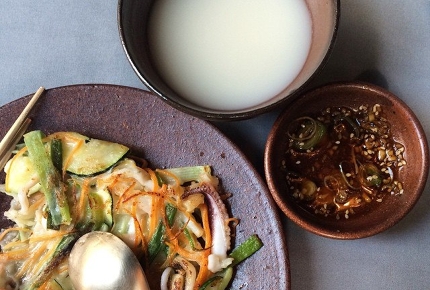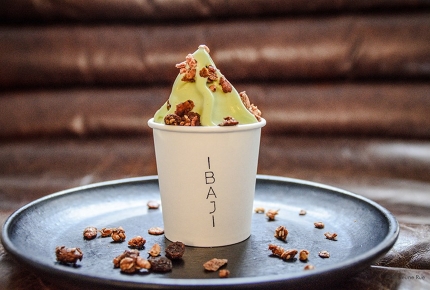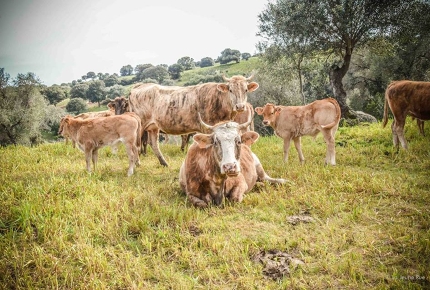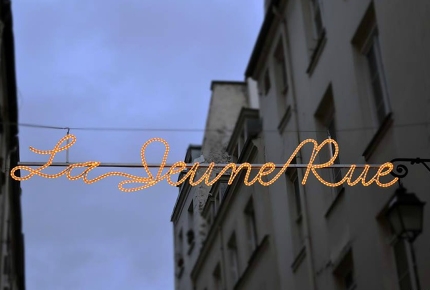La Jeune Rue: An improbable feast
Last year a French property tycoon bought an entire street in Paris, hoping to turn it into a foodie haven. But were his eyes bigger than his belly? Daniel Fahey finds out.
Rue de Vertbois, a slim, secluded street in the 3rd arrondissement of Paris, would be serenely silent if a small group of teenagers weren’t trying to boot a door in.
Bang. The chubby one gives it a kick.
Hidden behind the Musée des Arts et Métiers, this ramshackle street feels somewhat forgotten compared to nearby Rue de Turbigo and Boulevard Saint-Martin, which throng with Parisians going about their daily business.
The door judders in its frame.
Keen to change that, last year a local entrepreneur called Cédric Naudon revealed his plans to transform the rundown area along and around Rue de Vertbois into La Jeune Rue (The Young Street), a fantasy realm for gourmands.
Bang. He boots it again.
Supposedly rich through banking and property deals, little was known of Naudon except he was rarely seen without his costume: a silk scarf, an unbuttoned suit jacket and the well-sized waist of a frustrated chef.
The door holds out and the kid gives up.
In his vision, world-renowned chefs would work in restaurants fashioned by distinguished designers; butchers, cheesemongers and grocery stores would sell fresh, artisanal produce; and food waste would be all but eliminated. Even the stuffy French service would disappear.
 The project aimed to create a new food hub in Paris
The project aimed to create a new food hub in ParisLa Jeune Rue
So Naudon, who owns the Michelin-starred restaurant, Le Sergent Recruteur, bought up the street – or as much of it as he could. He recruited esteemed designers like Tom Dixon and Paolo Navone to create the right aesthetic and appointed his star chef, Antonin Bonnet, as chief of operations.
Bonnet would nurture the culinary side of the business: develop restaurant concepts, impart advice and hire people who turn ideas into realities. At least that was the plan.
A year on and the gulf between reverie and reality couldn’t be wider: lots sit empty; rental signs decorate darkened windows; and locals still buy their Brie and baguettes elsewhere.
When I visit, just three of the proposed restaurants have opened – an Argentinian steakhouse called Anahi (which existed previously, but was bought out, redesigned and reborn), Sicilian restaurant Pan, a few streets over, and Ibaji, a funky South Korean joint that cancelled my lunch booking due to annual holidays and construction work.
As for Bonnet, he fell out of love with the project on Valentine’s Day and now has nothing to do with it.
A culinary vision
Despite Naudon’s attempt to take over Rue de Vertbois, a handful of established businesses endure in the surrounding area. Sauntering a road over on an ageing spring afternoon, I notice a number of small independent shops: a smart-looking locksmiths; a dry cleaners with a busy owner in a fluffy moustache; and a baseball cap retailer called Picky Poo.
These enterprises remain resolute against the threat of gentrification, which is creeping up the street like ivy from nearby Le Marais. A sign of changing times if ever I saw one is the arrival of Greenwood Gallery, which sells contemporary artworks for as much as €14,990 a pop.
 Ibaji is a quirky South Korean joint
Ibaji is a quirky South Korean jointLa Jeune Rue
What the street really lacks, though, is good places to eat – and Le Marais doesn’t necessary have the answers either.
“Le Marais is rich in wonderful food shops, but consistently and confusingly pretty poor in terms of dining,” explains Meg Zimbeck, editor-in-chief of Paris By Mouth.
This is the culinary hole that Naudon endeavoured to fill: he wanted La Jeune Rue to be a one-stop shop for fresh, French produce; a place where people could do the groceries or take loved ones out for dinner.
Naudon declined my request for an interview, but his frustrations with the Parisian food scene are well known.
“Right now my Saturdays are eaten up having to go to the 7th arrondissement for good cheese, the 14th for meat, the 8th for bread and so on,” he told the New York Times. “Here, we'll bring everything together.”
Bonnet shared the vision and believed that for every job La Jeune Rue would create in Paris, a further 10 would spring up in the countryside.
Sour taste
So where did it go wrong? “We realised that it was super complicated [for the produce] to come all the way to us,” Bonnet tells me. “We are one of the first ones to want to do this to a higher level in Paris. At the time [the logistical side didn't exist] – and that hurt us financially.”
With my lunch at Ibaji cancelled, I ate that evening in Anahi – the Argentinian steakhouse set in a former butchers.
From the outside, it looks worn and aged, but inside designer Maud Bury has balanced its original features with touches of angelic artistry: copper leaf sparkles between the cracks in the sterile tiles; flames dance atop golden candelabras; gold-backed chairs stand beneath crisp white tablecloths.
 Anahi's beef comes from farms in Irissarry
Anahi's beef comes from farms in IrissarryLa Jeune Rue
It’s all about provenance here. My slab of well-salted steak, the chef tells me, came from Irissarry, the green salad from Cergy and Carrières-sur-Seine, and the dressing from Port Vendres.
After the beef, I treat myself to the most luxurious chocolate brownie I'm ever likely to eat: it's rich, laden with walnuts and comes with velvety vanilla ice cream and milk jam.
On this gastronomic evidence, La Jeune Rue should be a runaway success – but its future looks decidedly uncertain. In February, 10 of the companies involved in the project went into liquidation or receivership and the National Directorate of Tax Investigations searched Naudon's offices.
From my table at Anahi, I admire a caricature of Rich Uncle Pennybags chasing dollars, which has been graffiti-ed onto the shutters of Aqua Leathers, one of the area's last-standing wholesalers. It’s the telltale handiwork of New York artist, Alec Monopoly, but it could equally be a dig at Naudon.
Some have argued that his project, with all its good intentions, has forced more working class businesses out of central Paris. Its failure to come to fruition yet means people are without jobs and a bad taste has been left in the mouth of good chefs and designers.
“I think the issue nowadays, with society, is that everyone thinks that everything happens overnight,” says Bonnet, defending the project. “To grow a proper pig it will take 18 months; to kill it, to put into ham and to brine it, another 24. If you want something exceptional: 36.
“When you want to do a project like La Jeune Rue, you can't build it in five years,” he adds. “It just doesn't happen.”
But will the people of Paris wait any longer for this project to materialise? More to the point: will it ever materialise? Like Naudon, answers to those questions remain elusive.
“At the time that I left it was almost stopped – it wasn't dead,” says Bonnet. “But for me it was better to jump off the boat or the train to look for the next thing.”
 The street has yet to draw the crowds expected
The street has yet to draw the crowds expectedLa Jeune Rue
So where can we eat in the meantime?
While the La Jeune Rue project lumbers on, here are five of the best places to eat in the 3rd arrondissement:
1) Candelaria (52 rue de Saintonge)
Whether you’re after tacos or tequila, this tiny taqueria (taco shop) will sate any Mexican cravings. Small, yes, but with a punch like a poblano this snug joint is the best place for Latin American grub in Paris.
2) Le Mary Celeste (1 rue Commines)
Le Mary Celeste is a wonderful small-plate restaurant where the menu changes daily and the food is made to share. Expect anything from steamed oysters to kale salads.
3) The Beast (27 rue Meslay)
The last time the Yanks made such an entrance in Paris, Hemingway was smashing vases in Shakespeare & Company. The Beast is a new barbecue joint with all the bourbon and slow roasting you’d want from a Texan smokehouse.
4) Café Pinson (6 rue du Forez)
With its elbows out among the health kick queens of the Parisian dining scene, Café Pinson balances vegetarian, organic and gluten-free food without losing any of the tasty bits.
5) Chez L’Ami Louis (32 rue du Vertbois)
Its regulars jokingly call Chez L’Ami Louis the “worst restaurant in the world”, but with foie gras, fries and duck the constant dish of the day, this French bistro remains the best name on the street.
NEED TO KNOW
How to get there
The fastest – and greenest – way of getting to Paris is via the Eurostar (+44 3432 186 186; www.eurostar.com). Eurostar operates up to 18 daily services from London St Pancras International to Paris with return fares from £72. The fastest London-Paris journey time is 2 hours 15 minutes. From Gare du Nord train station, take Line 5 on the Metro to République, and Rue de Vertbois is a five-minute walk from there.
More information
La Jeune Rue: www.lajeunerue.com
Paris Tourist Office: en.parisinfo.com
Do you have any Feedback about this page?
© 2025 Columbus Travel Media Ltd. All rights reserved. No part of this site may be reproduced without our written permission, click here for information on Columbus Content Solutions.









 You know where
You know where